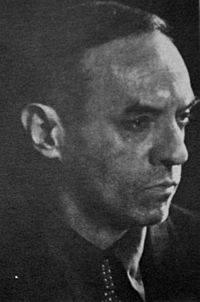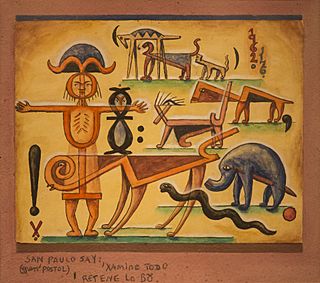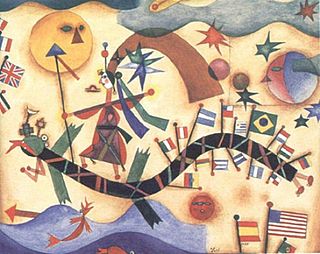Xul Solar facts for kids
Quick facts for kids
Xul Solar
|
|
|---|---|

Xul Solar
|
|
| Born |
Oscar Agustín Alejandro Schulz Solari
December 14, 1887 |
| Died | April 9, 1963 (aged 75) |
| Nationality | Argentine |
| Known for | Painter, sculptor, writer |
| Movement | Expressionist, surrealist, symbolist, modernist |
Xul Solar was the special name chosen by Oscar Agustín Alejandro Schulz Solari (born December 14, 1887 – died April 9, 1963). He was an Argentine artist, known for his paintings, sculptures, and writings. He even created his own imaginary languages.
Contents
About Xul Solar's Life
Xul Solar was born in San Fernando, Buenos Aires, Argentina. His family was from different parts of the world. His father was from Riga, which is now in Latvia. His mother was from Italy.
He grew up in Buenos Aires. First, he studied music, then architecture. He never finished his architecture studies. After working different small jobs, he traveled to Europe in 1912. He visited many cities like London, Paris, and Milan.
During World War I, he became good friends with another Argentine artist, Emilio Pettoruti. This friendship lasted his whole life. Around this time, Xul Solar started focusing more on painting. He mostly used watercolors, but also tempera and sometimes oils.
How He Chose His Name
In 1916, Oscar Schulz Solari started signing his art as "Xul Solar." He picked this name to make it sound simpler. But there's a deeper meaning! "Xul" is "lux" (Latin for "light") spelled backward. "Solar" means "of the sun." So, his name means "the light of the sun." This shows his interest in light and energy. His father's last name, "Schulz," sounds like "Xul" in Spanish.
Returning Home and New Friends
Xul Solar continued to travel in Europe, visiting places like Munich. In 1924, his art was shown in Paris. Later that year, he returned to Buenos Aires. There, he joined a group of modern artists and writers called the "Florida group."
In this group, he met famous writer Jorge Luis Borges. They became close friends and shared many interests. He also met the writer Leopoldo Marechal, who wrote about Xul Solar in his book Adán Buenosayres.
Xul Solar often showed his art in galleries in Buenos Aires and Montevideo. Near the end of his life, in 1962, he had a big art show in Paris. He passed away in 1963 at his home in Tigre, Buenos Aires.
What Xul Solar Created and Liked
Xul Solar's paintings are often small. They use bright colors and strong contrasts. His art style is unique, mixing ideas from artists like Wassily Kandinsky and Paul Klee. He also created art in unusual ways, like changing pianos. He even made a piano with three rows of keys!
His Special Interests
Xul Solar was very interested in astrology, which is the study of how stars and planets might affect people. He started drawing astrological charts in 1939. He also believed in Buddhism and reincarnation, the idea of being reborn. He even made his own Tarot cards. His paintings often show his spiritual beliefs, with images like stairs, roads, and symbols of God.
Invented Languages and Games
Xul Solar was very creative and invented two complete imaginary languages. He used symbols from these languages in his paintings. One language was called "Neo Criollo." It was a mix of Portuguese and Spanish. He even spoke it with people!
He also invented "Pan Lingua." This language was meant to connect math, music, astrology, and art. It was a bit like a "glass bead game" from a famous book. Xul Solar loved games. He even created his own version of chess, which he called "non-chess." He once said, "I am maestro of a writing no one reads yet."
His Friendship with Borges
Xul Solar is also well-known for his friendship with the writer Jorge Luis Borges. In 1940, Borges included Xul Solar as a character in one of his stories. In 1944, Xul Solar drew pictures for a special book written by Borges and another writer. They shared interests in German poetry, the works of Emanuel Swedenborg, and Eastern philosophy, like Buddhism.
Xul Solar's Legacy
In 1939, Xul Solar started an idea for a "universal club" called "Pan Klub." He wanted it to be a place for thinkers and people with shared interests to meet. He started the club in his own home.
Many years later, his wife, Micaela (Lita) Cadenas, created the Fundación Pan Klub. This foundation opened the Museo Xul Solar in 1993. The museum's design was inspired by Xul Solar's art. It shows his works, sculptures, and his personal papers. The foundation also takes care of Xul Solar's home, which holds his large library.
From 1980 to 1996, a literary magazine in Argentina was named Xul. The magazine was named after Xul Solar to honor him. They said he was a very complex person and a great artist in Argentina.
Quotes from Xul Solar
Here is something Xul Solar wrote about himself:
I am a world champion of a game that nobody yet knows called panchess. I am master of a script that nobody yet reads. I am creator of a musical technique that lets you learn piano much faster. I am director of a theater that hasn't started yet. I am creator of a universal language called panlingua, based on numbers and astrology, that will help people understand each other better. I am creator of twelve painting techniques, some of them surrealist, and others that bring feelings to the canvas. I am the creator of a language that Latin America really needs right now.
Selected Exhibitions
- 1920 – Xul Solar and the sculptor Arturo Martini, Galleria Arte, Milan
- 1924 – Exposition d’Art Américain-Latin, Musée Gallièra, Paris
- 1924 – Primer Salón Libre, Witcomb, Buenos Aires
- 1925 – Salón de los Independientes, Buenos Aires
- 1926 – Exposición de Pintores Modernos, Amigos del Arte, Buenos Aires
- 1929 – Xul Solar, Amigos del Arte, Buenos Aires
- 1930 – Salón de Pintores y Escultores Modernos, Amigos del Arte, Buenos Aires
- 1940 – Xul Solar, Amigos del Arte, Buenos Aires
- 1949 – Xul Solar, Galería Samos, Buenos Aires
- 1951 – Xul Solar, Galería Guión, Buenos Aires
- 1952 – Pintura y Escultura Argentina de Este Siglo, Museo Nacional de Bellas Artes, Buenos Aires
- 1953 – Xul Solar, Galería van Riel, Sala V, Buenos Aires
- 1963 – Homenaje a Xul Solar, Museo Nacional de Bellas Artes, Buenos Aires
- 1965 – Xul Solar: Exposición Retrospectiva, Galería Proar, Buenos Aires
- 1966 – III Bienal Americana de Arte: Homenaje a Xul Solar, Museo Provincial de Bellas Artes, Córdoba
- 1978 – Xul Solar, Galería Rubbers, Buenos Aires
- 1993 – Xul Solar: A Collector’s Vision, Rachel Adler Gallery, New York
- 1994 – Xul Solar: the Architectures, Courtauld Institute Galleries, London
- 2005 – Xul Solar: Visiones y Revelaciones, Colección Costantini, Buenos Aires
- 2013 – Xul Solar and Jorge Luis Borges: The Art of Friendship, Americas Society, New York; and Phoenix Art Museum, Phoenix, AZ.
Selected Works
- Nido de Fénices, Oil on board, c. 1914, private collection
- Paisaje con Monumento, Oil on board, c. 1914, Private collection, Buenos Aires
- Dos Anjos, 1915, Watercolor on paper, Museo Xul Solar, Buenos Aires
- Entierro, 1915, Watercolor on paper, Museo Xul Solar, Buenos Aires
- Ofrenda Cuori, 1915, Watercolor on paper mounted on card, Museo Xul Solar, Buenos Aires
- Reptil Que Sube, 1920, Watercolor on paper, Museo Xul Solar, Buenos Aires
- Casas en Alto, 1922, Watercolor on paper, Museo Xul Solar, Buenos Aires
- Grafía Antiga, 1939, Tempera on paper, Museo Xul Solar, Buenos Aires
- Fiordo, 1943, Tempera on paper, Museo Xul Solar, Buenos Aires
- Pan Game and Marionette I Ching at the Museum of Modern Art (c. 1945)
- Casi Plantas, 1946, Tempera on paper, Museo Xul Solar, Buenos Aires
- Muros Biombos, 1948, Watercolor on paper, Museo Xul Solar, Buenos Aires
- Pan Arbol, 1954, Watercolor on paper, Museo Xul Solar, Buenos Aires
- Cruz, 1954, Wood and watercolor, Museo Xul Solar, Buenos Aires
- Grafía, 1961, Tempera on paper, Museo Xul Solar, Buenos Aires
- Mi Pray Per To Min Guardianjo, 1962, Tempera on paper, Museo Xul Solar, Buenos Aires
See also
 In Spanish: Xul Solar para niños
In Spanish: Xul Solar para niños



